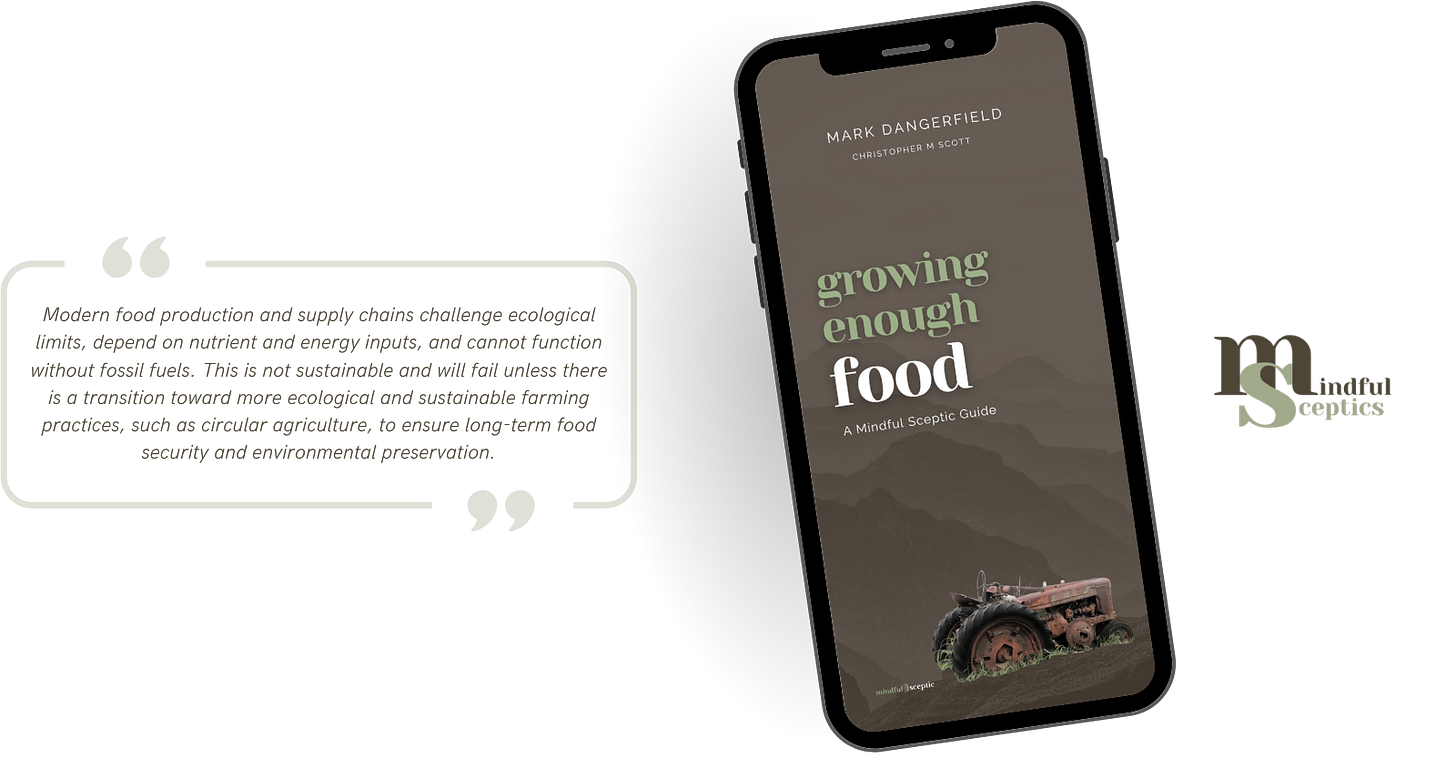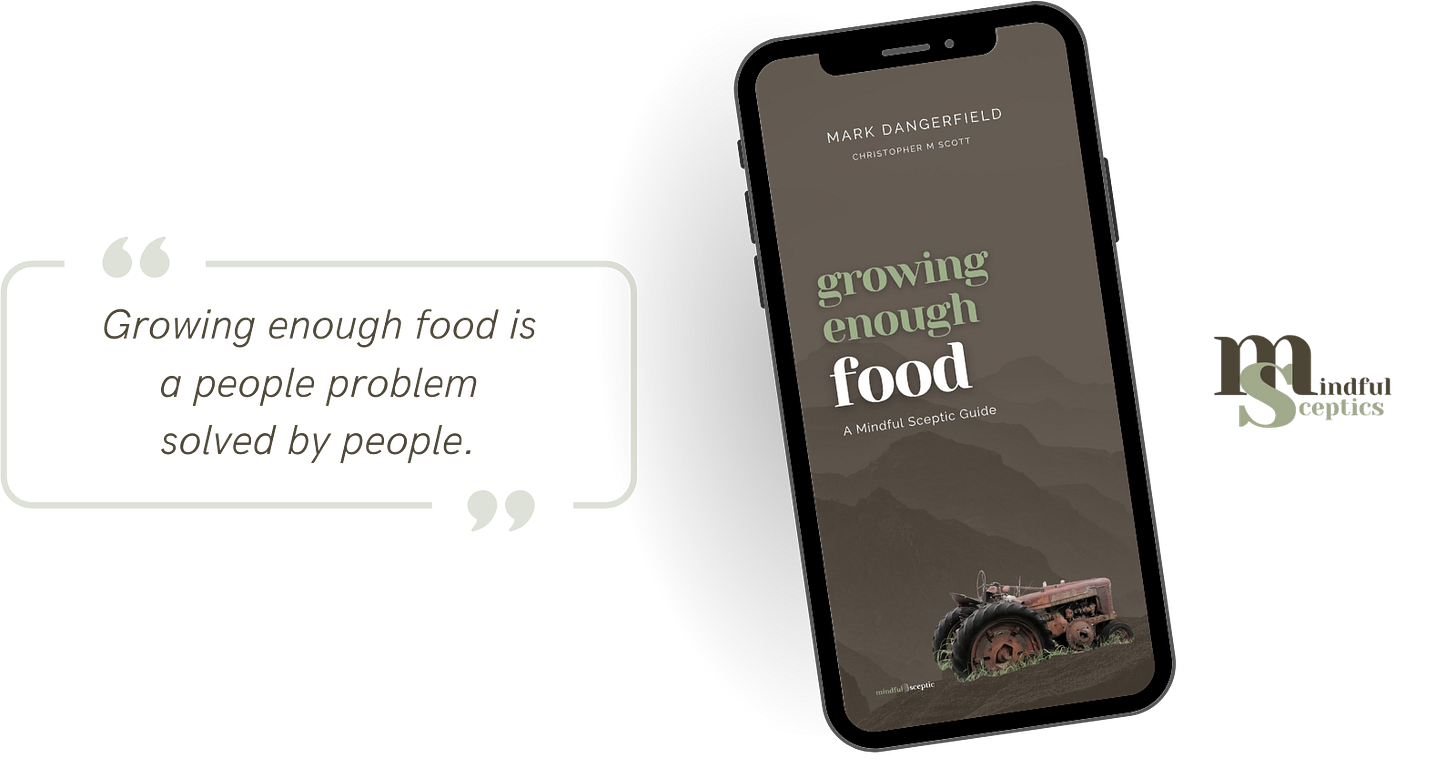Surplus Is Not Security
Energy Blindness Allows The Myth of Food Production Efficiency
Core Idea
The conventional wisdom has it that modern agriculture is a triumph of efficiency, delivering more food from less land, thanks to dazzling machinery, “smart” chemicals, and financial ingenuity.
It’s a seductive narrative.
Regular global harvests feed billions, supermarkets bulge, and all it takes is a touch of “innovation” to patch up any shortfall. Progress, the story whispers, is simply a matter of doing what we did yesterday, only bigger and faster.
In this story, intensification is beneficial because fewer hands are needed, yields appear higher by magic, and logistics are streamlined. Policymakers and agribusiness alike treat the energy needed for all this activity as a technical problem solved by the next subsidy or gadget.
The mostly urban public buys the line that our food system is not only robust but inexorably improving. And the math appears clear. Efficiency means more food and more people prospering.
Plus, for the most part, food has been and continues to be cheap for those who can shop in supermarkets.
Who dares to question such a compelling story with a happy ending?
Counterpoint
Contrary to this efficiency myth, intensification is actually an energy addiction hiding behind the mask of innovation.
The modern food system transformed agriculture from a net energy provider to a net energy sink. A historic pivot so profound it rivals the invention of agriculture itself, but whereas the first agricultural revolution built surpluses from nature’s solar flows, today’s behemoth is hooked on fossil fuels.
More yield?
Yes, but only if you ignore the fossil energy sluiced into every field, every harvest, every refrigerated truck, the very bloodstream of the system.
The math of intensification is clear, and it’s reckless. It burns through centuries of natural capital in soil carbon, nutrients, biodiversity, and fossil energy to convert sunlight into the briefest burst of profits.
Machinery replaces muscle, but only by siphoning petroleum. Fertiliser fattens crops, but only by strip-mining natural gas. Processing, packaging, shipping, and points of sale all run on borrowed energy.
Behind the triumphant yield graphs is the reality that Western food systems use up to 10 times more energy growing, shipping, and cooking food than the calories actually consumed. Modern agriculture is not feeding the world through efficiency; it’s feasting on the world’s fossil reserves and leaving the bill for the next generation.
Efficiency, in this context, is a lie of omission.
The supposed progress is paid for with mounting soil degradation, shrinking organic matter, collapsing biodiversity, and an ever-growing dependence on geopolitical energy flows.
When global supply chains hiccup, or oil gets expensive, or climate shifts come knocking, the edifice wobbles.
We call this resilience, when in reality, we’ve built an empire on sand.
Thought Challenges
Compare the energy balance… Try tracing the energy used to produce, process, and deliver a single meal. How does the fossil energy input compare to the caloric energy output? How would these numbers shift in a low-input system or in your own garden?
Analyse resilience scenarios… Consider what would happen to food availability and prices if fossil fuel supplies were drastically restricted for one year. Where does the system bend, and where does it break?
Closing Reflection
Progress is a tempting story, and there is truth in it. We do grow more food than ever, deliver it to where it is needed, and feed 8 billion people most of the time.
But realists notice that the debt is mounting.
Modern agriculture has an energy habit, and like all addictions, it denies the limits until collapse is the only teacher left.
Clarity means seeing the costs, not hiding behind the comfort of efficiency. The food system is only as resilient as the energy upon which it stands.
Evidence Support
Foley, J. A., et al. (2011). Solutions for a Cultivated Planet. Nature, 478(7369), 337–342.
TL;DR... outlines how current agricultural systems drive vast environmental changes, including land degradation, biodiversity loss, and greenhouse gas emissions. It synthesises approaches to produce sufficient food for a growing global population while reducing negative impacts through sustainable intensification and targeted conservation.
Relevance to insight… analysis is foundational to understanding the ecological limits to food production and the urgent need for a paradigm shift.
Smith, P., et al. (2016). Agriculture, Forestry and Other Land Use (AFOLU). In Climate Change 2014: Mitigation of Climate Change (IPCC AR5), Cambridge University Press.
TL;DR… data on land-based food production and its contributions to climate change, especially through fossil energy use, land clearing, and degradation. It finds that reducing reliance on fossil fuels, improving soil management, and diversifying farming systems are essential for long-term sustainability and climate resilience.
Relevance to insight… review by IPCC authors provides the most authoritative synthesis of evidence linking food production practices, land degradation, and climate risk. The recommendations for ecological transitions and soil stewardship directly support the demand for fundamental change away from energy-sink systems.
Poore, J., & Nemecek, T. (2018). Reducing Food’s Environmental Impacts through Producers and Consumers. Science, 360(6392), 987–992.
TL;DR… quantifies the environmental footprint of different foods, showing that current supply chains are highly energy-intensive and soil-depleting. It offers practical interventions—at producer and consumer levels—that can dramatically shrink the ecological cost of feeding the world.
Relevance to insight… hard numbers on resource use, carbon emissions, and supply-chain risks, making it a direct evidentiary backbone for claims about fragility, energy sinks, and ecological limits in modern food systems.
Godfray, H. C. J., et al. (2010). Food Security: The Challenge of Feeding 9 Billion People. Science, 327(5967), 812–818.
TL;DR… maps out the major scientific and policy challenges of sustaining a growing global population, emphasising yield gaps, soil constraints, resource limitations, and how business-as-usual agriculture amplifies risks of collapse.
Relevance to insight… biophysical and ecological boundaries within which food security must operate. Their synthesis serves as direct, independently vetted evidence for the limits and risks named in the insight.
Montgomery, D. R. (2007). Soil Erosion and Agricultural Sustainability. Proceedings of the National Academy of Sciences, 104(33), 13268–13272.
TL;DR… review of soil erosion rates under modern agriculture versus historic background rates, demonstrating that contemporary practices far outpace natural soil regeneration and threaten the sustainability of food systems.
Relevance to insight… comprehensive evidence for soil degradation, this paper is essential for substantiating the claim that industrial intensification creates unsustainable energy and nutrient sinks.






